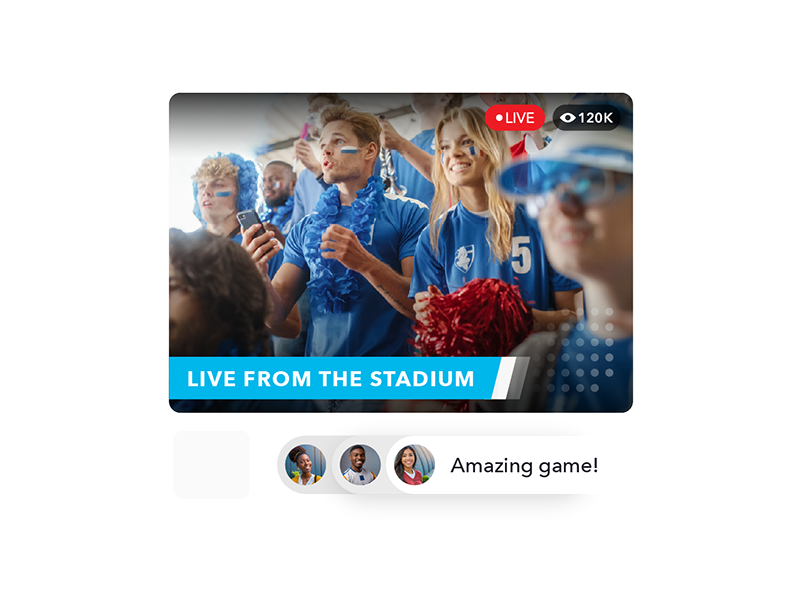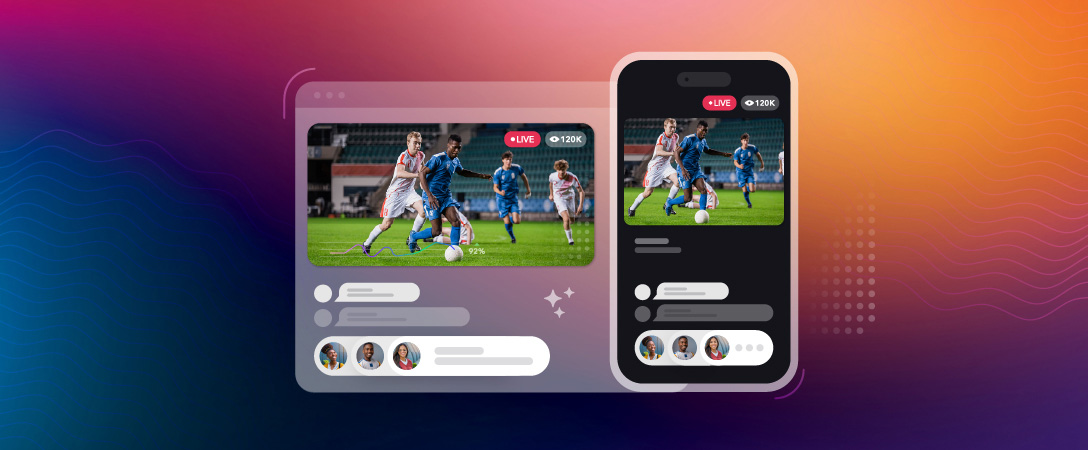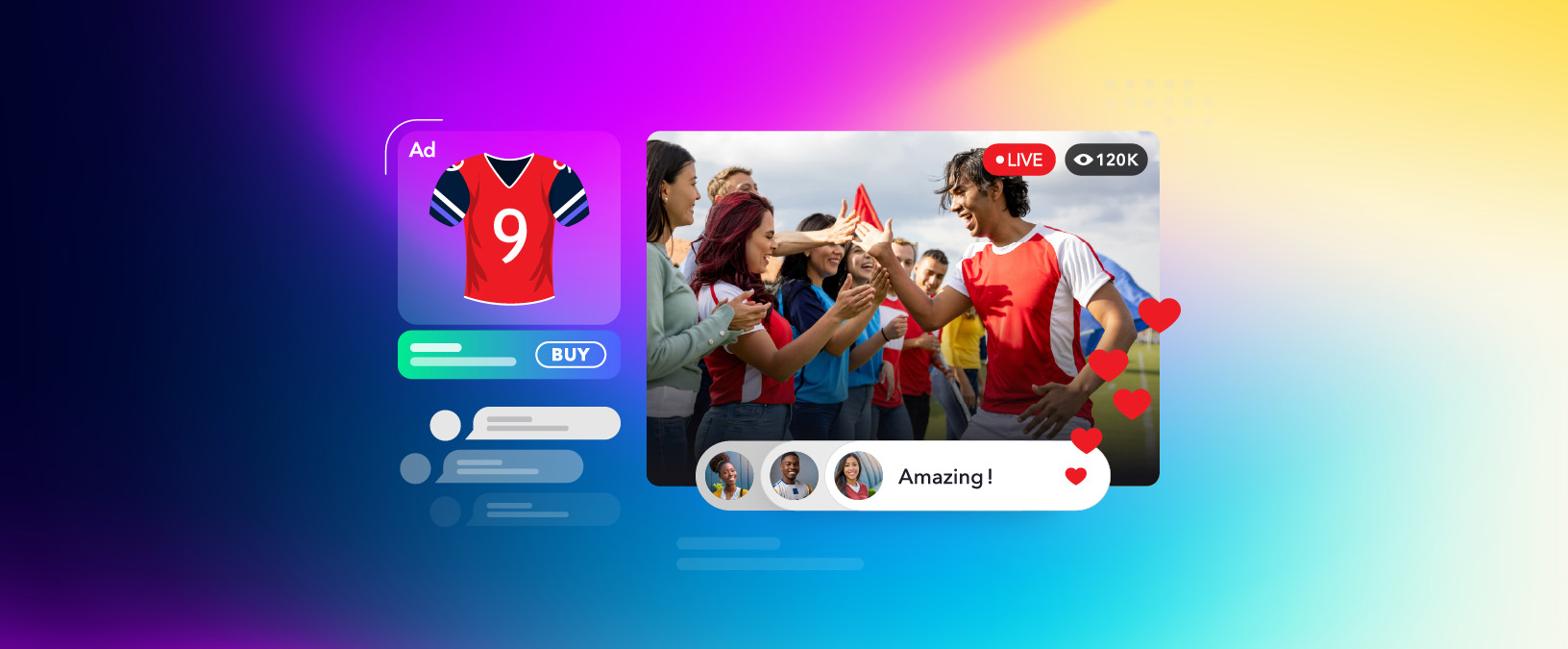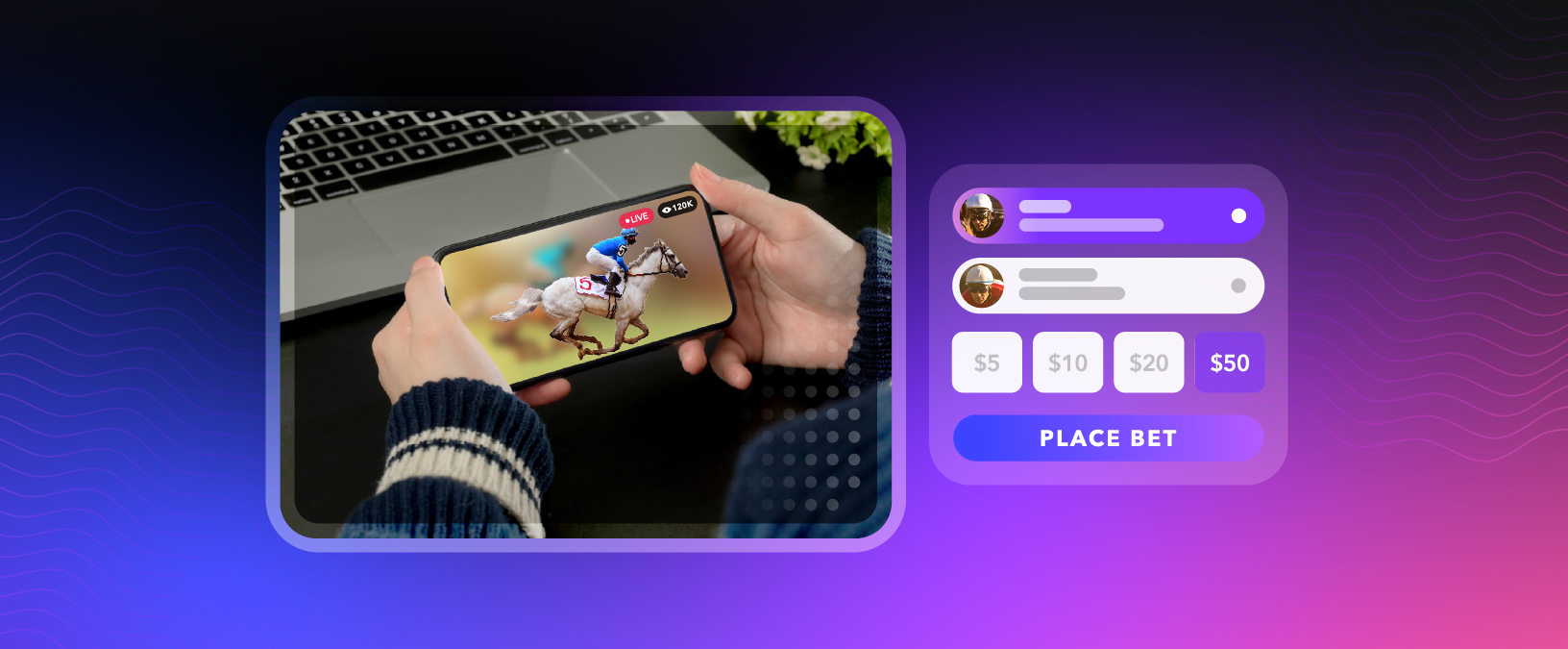With the integration of advanced technologies and a deep understanding of fan behavior, live sports operators can unlock new revenue streams while enhancing the overall fan experience. Success, however, hinges on converting passive fans into actively engaged ones year-round, not just during peak season.
In this blog post, we’ll explore five simple yet effective ways to increase revenue in live sports:
1. No More Off-Season: Year-round Fan Engagement
2. Live Sports Betting: Target Generation Z Fans
3. Contextual Advertising: Effective and Lucrative
4. Personalized Sports Content: Leverage User Data
5. Brand Sponsorship: Exclusive Events for Fans
Conclusion
Download our guide: “Go Beyond the Game and Boost Interactive Fan Experiences”
1. No More Off-Season: Year-round Fan Engagement
Today’s fans are always connected, always engaged, and always hungry for more content. The belief that fan engagement is only relevant during game days or within the season has been refuted. Recent data from a Deloitte survey showed that engaging with fans outside of the season can boost spending on tickets and merchandise by 52%. For marketers and sports content owners, this shift represents a golden opportunity to keep the conversation going 365 days a year.
Here are some strategies to keep fans engaged year-round:
- Preseason games: Host exhibition matches to generate excitement leading up to the regular season.
- Training camps: Provide behind-the-scenes access to training sessions.
- Live tailgate parties: Organize virtual or in-person tailgate events to foster community spirit.
- Virtual meet & greet sessions: Allow fans to interact with their favorite athletes in a virtual setting.
- Live post-game reactions & interviews: Share candid moments and insights immediately after games.
- Live draft picks: Broadcast live draft events to keep fans invested in team developments.
- Personalized streams created by athletes: Leverage athletes’ social media platforms for personalized content streams.
By leveraging these exclusive features, sports brands can exceed fan expectations, ensuring fan loyalty and generating increased revenue.

2. Live Sports Betting: Target Generation Z Fans
Live sports betting has transitioned from a niche activity to a mainstream phenomenon. With the legalization of sports betting in various regions and the proliferation of mobile betting apps, fans can now place bets in real-time as the action unfolds. This has fundamentally changed how fans interact with live sports, transforming passive viewers into active participants.
In-play betting offers a dynamic way to keep fans glued to their screens, creating emotional highs and lows that mirror the game’s excitement. By integrating live betting options directly into sports broadcasts and apps, sports content owners can offer a seamless and immersive experience.

“In the past year, 43% of Generation Z has placed a sports wager, with 25% placing a sports bet once a week.”
Source: Gen Z And Sports Gambling: How Much Are You Willing To Bet You’re Hooked?
Particular attention should be paid to Generation X fans, who crave a social and interactive experience.
To understand the impact of sports betting, consider the following statistics:
- In the past year, 43% of Generation Z has placed a sports wager.
- Whistle Wise reports that 83% of Gen Z agree that being able to bet on a sports league makes them more likely to be a fan of the league.
Social interaction plays a crucial role in the sports experience for this demographic. In general, sports bettors tend to be more active fans. Among those surveyed, bettors are more likely to have attended a game in person, bought sports merchandise, paid for a streaming video service to watch sports, bought season tickets, or participated in a fantasy sports league over the past 12 months.
Sports bettors are more engaged than non-bettors, with 61% of bettors having attended a live sporting event in person in the past 12 months, compared to 44% of non-bettors. By incorporating live sports betting into their offerings, sports operators can target this highly engaged audience, driving both engagement and revenue.
3. Contextual Advertising: Effective and Lucrative
Contextual advertising involves placing ads that are relevant to the content being consumed. Unlike traditional advertising, which can feel intrusive, contextual ads enhance the user experience by providing value and relevance.

For sports content owners and marketers, contextual advertising offers a lucrative opportunity to monetize content without alienating fans. Here are a few strategies:
- In-Game Advertising: Integrate ads that relate to the current game or event. For example, during a basketball game, ads for sports apparel or energy drinks can be seamlessly woven into the broadcast.
- Data-Driven Targeting: Utilize user data to deliver personalized ads based on viewers’ past behaviors and preferences. This increases the likelihood of engagement and conversion.
- Sponsored Segments: Create sponsored segments that align with the interests of your audience. For instance, a pre-game analysis sponsored by a sports betting company can add value while promoting the sponsor’s offerings.
By customizing streaming content and integrating sponsor messages seamlessly into live broadcasts, teams can create a more immersive and engaging experience for fans. In the realm of real-time streaming, the utilization of viewers’ personal data and browsing history stands as a game-changer, offering unprecedented revenue possibilities through targeted advertising and enriched viewer experiences.
Contextual ads, informed by the viewer’s specific interests in sports content, have a higher propensity to engage and resonate, thus amplifying their effectiveness in user interaction.
4. Personalized Sports Content: Leverage User Data
The ability to curate content based on individual fan preferences offers a level of personalization that traditional broadcast models can’t match. Understanding your audience however is critical for success. Leagues and teams must leverage data analytics to gain insights into their fans’ preferences, viewing habits, and engagement levels to provide a personalized and valuable viewing experience.
How to personalize sports content
- Customized highlights: Use AI and machine learning to curate highlight reels based on individual preferences. For example, a fan who follows a particular player can receive a personalized highlight reel of that player’s best moments.
- Personalized notifications: Send real-time notifications about games, scores, and news that align with the fan’s interests. Personalized push notifications can drive higher engagement rates.
- Exclusive content: Offer exclusive content, such as behind-the-scenes footage or interviews, to fans who have shown a strong interest in specific teams or players. This creates a sense of exclusivity and loyalty.
When done correctly, personalized fan experiences cater to individual preferences and geographical locations, which significantly elevates the fan experience. In addition to boosting fan engagement, it enables advertisers to pinpoint their target audiences with greater precision, maximizing ad impact and fostering a more connected and interactive digital environment for sports fans.
5. Brand Sponsorship: Exclusive Events for Fans
Brand sponsorships are a powerful way to generate revenue while offering fans unique and memorable experiences. Exclusive online events sponsored by well-known brands can create additional excitement and buzz around a sports team or league. These live events can range from VIP meet-and-greets to branded fan zones at stadiums, enhancing the overall game-day experience.

To maximize the impact of brand sponsorships, sports operators should partner with brands that align with their fan base’s interests and values. The key strategy here is to create exclusive experiences that fans can’t get elsewhere, making them feel special and valued. Sports marketers need to leverage social media and other digital channels to promote these events and engage with fans before, during, and after the events.
By offering real-time events and exclusive experiences, sports teams can attract sponsorship deals that not only increase revenue, but also enhance fan loyalty and engagement.
Creating exclusive fan experiences
- VIP access: Offer real-time streaming VIP access to events, such as meet-and-greets with athletes or behind-the-scenes tours. This not only enhances the fan experience but also provides valuable content for social media and marketing campaigns.
- Virtual events: In the age of digital connectivity, virtual events have become increasingly popular. Brands can sponsor virtual watch parties, live Q&A sessions with athletes, or interactive webinars on sports-related topics.
- Fan contests: Organize contests and giveaways that offer unique prizes, such as signed memorabilia or tickets to exclusive events. This encourages fan participation and fosters a sense of community.
Because the impact of social media on fan engagement is advancing more rapidly than ever, for sports organizations, it makes fiscal sense to prioritize social media posts featuring brand partners and created or shared by the athletes that fans adore. This content is on the front line of fan engagement and activation.
Conclusion
Increasing revenue in live sports requires a multifaceted approach that leverages technology, data, and innovative strategies to engage fans year-round. By focusing on year-round fan engagement, incorporating live sports betting, utilizing contextual advertising, personalizing sports content, and securing brand sponsorships, sports operators can unlock new revenue streams and create unforgettable experiences for their fans.
For stadium managers, sports teams, owners, marketing professionals, fan engagement specialists, and broadcasters, the future of live sports is bright. Embrace these strategies, and you’ll be well on your way to driving growth and success in the world of live sports.
Ready to take your live sports revenue to the next level?
Unlock the secrets to fan engagement success in live sports and download our expert guide, “Go Beyond the Game: Boost Interactive Fan Engagement with a Direct-to-Consumer Business Model in Live Sports” by filling out the form below for a complete roadmap.










